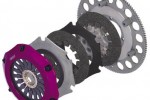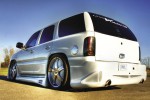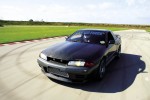The Arc Audio KS 125.4 is a fairly basic amplifier in terms of audio control features, but it certainly includes all the “required” ingredients. There are separate gain pots for each of the four channels, so getting the left to right “balance” set perfectly is simple. -12dB Butterworth crossovers are employed for both high and low pass, and can be adjusted from about 40Hz to 500Hz. The rear channels include a bass EQ function that is centered at 45Hz, (which is about perfect for most systems) and can provide up to 15dB of boost. Thankfully, the “Q” factor of this boost control is nice and narrow, making it far more useful and effective than some of those designed more to put a marketing bullet on the box than to actually use in real life. Make no mistake, the folks behind this amp, “get it”.
LISTENING
Lately my ears have been spoiled by the exceptionally superlative performance of a couple of very high-end home amplifiers I’ve been listening to, (by high-end, I mean amps that cost as much as a decent new car) and so I was quite conscious to avoid being overly critical of the next mere “car amp” I auditioned. As it turned out, I needn’t have been so concerned. Now while I’m certainly not going to tell you that the Arc Audio KS 125.4 sounds just like a Krell or Pass Labs amplifier, but when you consider what it is, and how much it costs, it’s certainly a welcome addition to the system in any car!
The Arc Audio KS 125.4 sounded very good throughout my listening trials. I configured it so the rear channels were bridged into my 4 ohm reference woofer, and the front channels drove my reference bookshelf speakers. With the front crossover filter set to all-pass, and the sub adjusted to about 80Hz, the amplifier was very musical, and virtually transparent. Bass was tight and very defined, with good power and authority considering the 250 watt rating. The full range front channels sounded as if the amplifier wasn’t there… which is about the nicest thing you can say about an amplifier. I didn’t notice any of the “compressed” type of sound I have noted on some recent full range Class D designs, and I think the Class AB and Class G designs may still have a slight sonic edge there. Stereo imaging was excellent, as was the decided lack of background noise. Other than a very slight amount of noise from the top mounted cooling fan, this thing is dead quiet. When the amp was pushed very hard, with the woofer occasionally driven well into clipping, I did notice the front channels also began to distort as the available current in the power supply was depleted. This however is common to most multi-channel amplifiers, and is certainly nothing specifically deleterious to the Arc Audio design.
One of my concerns when I saw the size of the heatsink and read the power ratings was whether or not the amp would pass muster from a thermal perspective. After listening to it for several hours at relatively high levels, I measured the surface temperature of the heatsink. The hottest spot I found was about 71°C, which is good and warm, but not hot enough to make the amplifier thermally protect. Now, I should remind you that the amp was inside my cool listening room, and not in a hot car trunk, so how it’s going to do in the Arizona summer remains to be seen, but I found no cause for thermal concern in my testing. And I have tested amplifiers that would thermal under the same conditions, so I’d have to say it’s very competitive from a thermal perspective.
PERFORMANCE / BENCH MEASUREMENTS
After I’d finished the listening part of the evaluation, I brought the amp into the electronics lab for a thorough examination. I’ve looked inside and measured thousands of amplifiers over the years, and sometimes I sort of develop my own performance expectations based on what I’ve just seen and heard. Before ever firing up the Audio Precision analyzer, I expected the Mini Arc Audio amp to surpass it’s published specs based simply on how it sounded and what I’d noted inside. The Arc Audio KS 125.4 did just that. It made more than advertised power at 4 and 2 ohms, and also at 4 ohms bridged. S/N was better than published as well, and the frequency response within human hearing was within 0.3dB from perfectly flat. When I noted how densely populated the PCB was, I wondered if the amp would have problems with crosstalk. Crosstalk, or stereo separation is the products ability to keep the signal on one channel from “leaking” or “crossing” into the other. I needn’t have worried, the Arc Audio KS 125.4 measured as good or better than almost any other car amp I’ve tested. Another kudo to the layout and design team! There was really very little to find fault with, maybe the overall power efficiency wasn’t quite as great as I expected, and I thought it could have had a bit more available gain… but really, that was about it for raspberries.
 |
 |
 |
The Conclusion
With their relatively modest power, these Mini amps are probably not going to be the first choice for a hard core SPL customer, but the Arc Audio Mini Series represent a high-tech and different approach to compact, good sounding amplifiers for the vast majority of enthusiasts everywhere. Everything I’ve seen here would indicate they’ll be reliable, easy to live with due to their small size, and you’ll look long and hard to find something that sounds significantly better. So in the end, if they sound good, fit in small places, and don’t break, what else could you ask for?
Related Articles
 Project R32: Proper Exedy Racing Clutch Selection
Project R32: Proper Exedy Racing Clutch Selection
 Getting Hyphy: Calvin Wan's 1993 Mazda RX-7
Getting Hyphy: Calvin Wan's 1993 Mazda RX-7
 BIG BALLIN'
BIG BALLIN'
 Rugrat: Sean Driscoll's 2004 Scion xB
Rugrat: Sean Driscoll's 2004 Scion xB
 Project R32: Adjustable Suspension Links
Project R32: Adjustable Suspension Links
 Serge Leger's Team ETC 2009 Cadillac CTS
Serge Leger's Team ETC 2009 Cadillac CTS





